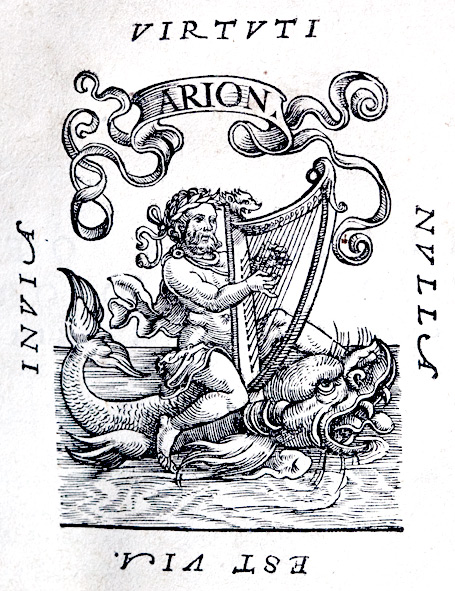 This post is written in honor of the 500th birthday of the great anatomist, Andreas Vesalius, who combined art and medicine in his landmark masterpiece, De Humani Corporis Fabrica. I am a lifelong fan of Vesalius and currently collaborating with the physician-scholar Michael Nevins on a study of the title page of the Fabrica. On a recent trip to the New York Academy of Medicine’s Rare Book Room we perused both the 1543 and 1555 editions of the Fabrica. Having studied many of the anatomical illustrations, I turned to the back of the great books and saw something surprising that I had never seen. It was the printer’s device – or mark – of Johannes Oporinus – the printmaker in Basel who drew upon the resources of his craft to produce the Fabrica in its full splendor that made such a mark in history.
This post is written in honor of the 500th birthday of the great anatomist, Andreas Vesalius, who combined art and medicine in his landmark masterpiece, De Humani Corporis Fabrica. I am a lifelong fan of Vesalius and currently collaborating with the physician-scholar Michael Nevins on a study of the title page of the Fabrica. On a recent trip to the New York Academy of Medicine’s Rare Book Room we perused both the 1543 and 1555 editions of the Fabrica. Having studied many of the anatomical illustrations, I turned to the back of the great books and saw something surprising that I had never seen. It was the printer’s device – or mark – of Johannes Oporinus – the printmaker in Basel who drew upon the resources of his craft to produce the Fabrica in its full splendor that made such a mark in history.
The printer’s mark features the Greek musician Arion playing a harp and riding a fanciful dolphin that looks more like a sea serpent. According to Herodotus in the 5th Century BC, Arion had won a valuable prize in a music contest and was returning home, when pirates decided to steal his treasure and kill him. Arion played his instrument with melodies that attracted creatures of the sea and jumped overboard, and was rescued by a dolphin who carried him to safety. The pirates were later hanged, and both the dolphin and Arion’s instrument became the constellations Delphinus and Lyra. Surrounding the image of Arion is a quote from Ovid’s Metamorphosis, the words of Sybil to Aeneas before his descent into Hades: invia virtuti nulla est via, or “valor knows no obstacle.”
It is said that Vesalius suggested this design to his friend Oporinus who had just gone into the book printing business and was about to work on the anatomical masterpiece. Even before first edition of the Fabrica, Vesalius’s work had been plagiarized all over Europe. He chose Basel over Venice to have his book printed to take advantage of the printer’s European connections and distribution network, and therefore gain advantage over the plagiarists he knew would descend. Both Vesalius and Oporinus drew upon the classical stories of Arion and Aeneas to produce an allegory of their own success in creating an indelible landmark in the history of medicine, art, and bookmaking.
Oporinus used this theme for his device in all of his books beginning with the Fabrica. In the 1555 second edition, the mark was recut to feature a tall man with one foot on the dolphin, the other on dry land, with a dolphin that is less heroic and a tone less flamboyant. This wasn’t the only image that was changed for the second edition, as they included the title page and most of the historiated initials.
I had the wonderful opportunity to photograph both printer’s devices directly from the Fabricas owned by the New York Academy of Medicine and present them above and below. To me they represent the triumph of art, science, and truth, as well as the combination of hard work and favor of the gods that are necessary to earn a place in the universe. Just like Arion’s instrument and the dolphin that saved him, Andreas Vesalius and his Fabrica, with the help and skill of Johannes Oporinus have become fixtures in the sky.

* * * * * * * * * * * * * * *
I am indebted to Arlene Shaner, Acting Curator and Reference Librarian for Historical Collections at the New York Academy of Medicine, for her assistance with viewing these books.
References for this post included:
Clark, H. Foiling the pirates: The preparation and publication of Andreas Vesalius’s De humani corporis fabrica. Library Quarterly, 51(3): 301-311.
Fisch, MH. The printer of Vesalius’s Fabrica. Bull Med Libr Assoc. Jul 1943; 31(3): 240–259.
For more information on the New York Academy of Medicine’s Vesalius500 celebration click here.
For information on other celebrations of Vesalius’s 500th birthday around the world click here.
Visit the website of my colleague and mentor in medical history, Dr. Michael Nevins here.
.

Thank you for this great article. I have been a fan of Vesalius for a long time and am presently writing a novel (in German) in which he plays a central part. I have reached a point where I need to describe the printer’s device and so I came across your website. It’s good to know that Vesalius has fans!!
What a wonderful historical review of the greats in a era long gone. They were great descriptive physicians, even epidemiologists in their day with no real treatments for disease, but good surgeons at time. Pity we have no such colleagues anymore. The Giants of Medicine are no longer. Joel